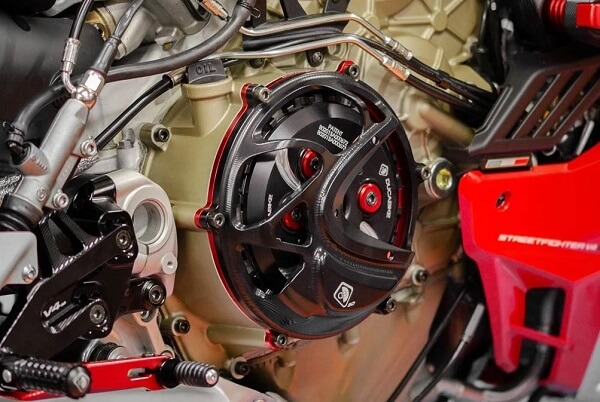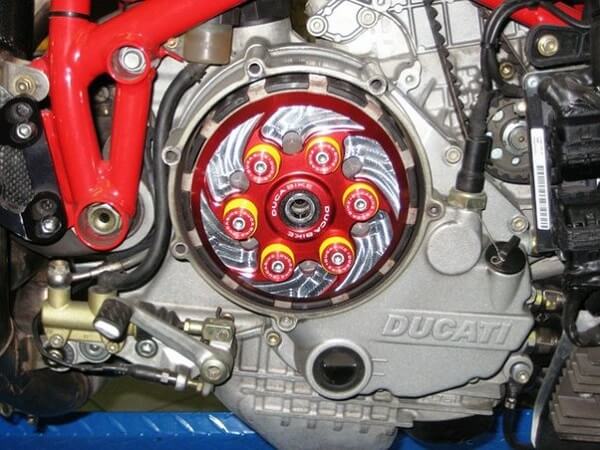
When it comes to transmitting torque and facilitating the engagement and disengagement of a clutch, there are two main types of systems to choose from
wet clutch vs dry clutch. But what is the difference between them, and how do they work? In this article, we'll take a closer look at wet clutches and dry clutches. Understanding the differences between wet clutches and dry clutches can help you make an informed decision.
What is a Wet Clutch?

A wet clutch uses a fluid, typically oil, to transmit torque and facilitate the engagement and disengagement of the clutch. Wet clutches are often found in automotive transmission systems and other types of machinery that require a smooth and controlled transfer of power.
How Does a Wet Clutch Work?
The wet clutch plates are immersed in oil, which helps to lubricate and cool the system as it operates. When engaged, the plates come into contact with each other and transmit torque through the oil. When the clutch is disengaged, the plates are separated, and the torque transfer is interrupted.
The oil helps reduce wear on the clutch plates and prolong the system's life, allowing for a smoother and more controlled engagement and disengagement, which can be beneficial in applications where precise control of torque transfer is important.
What is a Dry Clutch?

Instead of using a fluid to transmit torque, the dry clutch's plates come into direct contact with each other to transmit torque and facilitate the engagement and disengagement of the clutch.
How Does a Dry Clutch Work?
In a dry clutch system, the clutch plates are separated by a thin layer of air when the clutch is disengaged. When the clutch is engaged, the plates come into contact with each other and transmit torque through friction.
One advantage of dry clutches is that they tend to be smaller and lighter than wet clutches, which can be beneficial in applications where space and weight are a concern. They are also typically more straightforward and less expensive to manufacture and maintain.
However, dry clutches can be more prone to wear and require more frequent maintenance due to the direct contact between the plates. They may also be less smooth and more abrupt in their engagement and disengagement compared to wet clutches, which can be a disadvantage in some applications.
What is the Difference Between a Wet Clutch and a Dry Clutch?

One key difference between wet and dry clutches is how they transmit torque. Wet clutches use a fluid to facilitate torque transfer, while dry clutches rely on direct contact between the plates.
Another difference is the level of wear and maintenance required. Wet clutches tend to have a longer lifespan and require less frequent maintenance due to the lubricating effect of the oil. On the other hand, dry clutches may require more frequent maintenance due to the direct contact between the plates and may be more prone to wear.
In terms of size and weight, dry clutches tend to be smaller and lighter than wet clutches, which can be an advantage in some applications. On the other hand, wet clutches may be more suitable for applications where smooth and precise control of torque transfer is essential.
Ultimately, the choice between a wet clutch and a dry clutch will depend on the specific requirements and needs of the application. Factors such as the level of torque transfer required, the space and weight constraints of the system, and the frequency of maintenance and repair may all play a role in the decision.
FAQ
Does a wet clutch need oil?
The answer is an absolute yes. The oil helps lubricate and cool the system as it operates, reducing wear and prolonging its life. Without the oil, the wet clutch would not be able to function correctly.
At what mileage should a clutch be replaced?
In general, clutches can last for a wide range of miles, from as little as 20,000 to more than 100,000 miles. Some may need replacing earlier due to excessive wear or damage. In contrast, others may last much longer with proper maintenance and care.
What does a damaged clutch feel like?
There are a few common symptoms that can indicate a damaged or worn clutch:
- Slipping: it may feel like the engine is revving up without the vehicle accelerating when the clutch plates cannot transmit enough torque to the transmission.
- Grinding or shaking when engaged or disengaged may signify damage or wear.
- Hard to shift: The clutch requires more effort to engage or disengage
- Burning smell: If a burning smell comes from the clutch area, it may be a sign of excessive heat or wear.
- Noise: If the clutch is making unusual noises, such as squealing, whining, or clicking, it may be a sign of a problem.
Why is dry clutch better than wet clutch?
Dry and wet clutches have unique characteristics and benefits, and the decision of which one to use will depend on the specific requirements and needs of the application. Here are a few potential advantages of dry clutches over wet clutches:
- Smaller and lighter than wet clutches, which can be advantageous in applications where space and weight are a concern.
- Simpler and less expensive to manufacture and maintain than wet clutches.
- Quieter than wet clutches, which can benefit some applications.
Dry clutches may be more prone to wear and require more frequent maintenance due to the direct contact between the plates. They may also be less smooth and more abrupt in their engagement and disengagement compared to wet clutches, which can be a disadvantage in some applications.
https://gokartwiki.com/wet-clutch-vs-dry-clutch/?feed_id=36&_unique_id=649ddc33dc4d3
 When it comes to transmitting torque and facilitating the engagement and disengagement of a clutch, there are two main types of systems to choose from wet clutch vs dry clutch. But what is the difference between them, and how do they work? In this article, we'll take a closer look at wet clutches and dry clutches. Understanding the differences between wet clutches and dry clutches can help you make an informed decision.
When it comes to transmitting torque and facilitating the engagement and disengagement of a clutch, there are two main types of systems to choose from wet clutch vs dry clutch. But what is the difference between them, and how do they work? In this article, we'll take a closer look at wet clutches and dry clutches. Understanding the differences between wet clutches and dry clutches can help you make an informed decision.
 A wet clutch uses a fluid, typically oil, to transmit torque and facilitate the engagement and disengagement of the clutch. Wet clutches are often found in automotive transmission systems and other types of machinery that require a smooth and controlled transfer of power.
A wet clutch uses a fluid, typically oil, to transmit torque and facilitate the engagement and disengagement of the clutch. Wet clutches are often found in automotive transmission systems and other types of machinery that require a smooth and controlled transfer of power.
 Instead of using a fluid to transmit torque, the dry clutch's plates come into direct contact with each other to transmit torque and facilitate the engagement and disengagement of the clutch.
Instead of using a fluid to transmit torque, the dry clutch's plates come into direct contact with each other to transmit torque and facilitate the engagement and disengagement of the clutch.
 One key difference between wet and dry clutches is how they transmit torque. Wet clutches use a fluid to facilitate torque transfer, while dry clutches rely on direct contact between the plates.
Another difference is the level of wear and maintenance required. Wet clutches tend to have a longer lifespan and require less frequent maintenance due to the lubricating effect of the oil. On the other hand, dry clutches may require more frequent maintenance due to the direct contact between the plates and may be more prone to wear.
In terms of size and weight, dry clutches tend to be smaller and lighter than wet clutches, which can be an advantage in some applications. On the other hand, wet clutches may be more suitable for applications where smooth and precise control of torque transfer is essential.
Ultimately, the choice between a wet clutch and a dry clutch will depend on the specific requirements and needs of the application. Factors such as the level of torque transfer required, the space and weight constraints of the system, and the frequency of maintenance and repair may all play a role in the decision.
One key difference between wet and dry clutches is how they transmit torque. Wet clutches use a fluid to facilitate torque transfer, while dry clutches rely on direct contact between the plates.
Another difference is the level of wear and maintenance required. Wet clutches tend to have a longer lifespan and require less frequent maintenance due to the lubricating effect of the oil. On the other hand, dry clutches may require more frequent maintenance due to the direct contact between the plates and may be more prone to wear.
In terms of size and weight, dry clutches tend to be smaller and lighter than wet clutches, which can be an advantage in some applications. On the other hand, wet clutches may be more suitable for applications where smooth and precise control of torque transfer is essential.
Ultimately, the choice between a wet clutch and a dry clutch will depend on the specific requirements and needs of the application. Factors such as the level of torque transfer required, the space and weight constraints of the system, and the frequency of maintenance and repair may all play a role in the decision.
Comments
Post a Comment